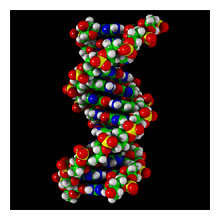Freedom

Ray Kurzweil and Bill Joy have co-written an op-ed in today's New York Times. They say that publishing the genome of the 1918 influenza virus is as irresponsible as publishing atomic bomb specifications. Because it is important, I will publish their full warning here: Recipe for Destruction:
After a decade of painstaking research, federal and university scientists have reconstructed the 1918 influenza virus that killed 50 million people worldwide. Like the flu viruses now raising alarm bells in Asia, the 1918 virus was a bird flu that jumped directly to humans, the scientists reported. To shed light on how the virus evolved, the United States Department of Health and Human Services published the full genome of the 1918 influenza virus on the Internet in the GenBank database.I find their argument compelling. It was foolish to publish the entirety of the 1918 genome and hope for the best. Now we have yet another chunk of public data in our world that will always be hanging over us. We live in an era where the President obsesses over the proliferation of weapons of mass destruction, leading to fundamental changes in foreign policy. The threat is real, and growing. I wonder: did the decision of whether or not to publish the 1918 influenza genome ever cross the President's desk? I would bet not. Why?
This is extremely foolish. The genome is essentially the design of a weapon of mass destruction. No responsible scientist would advocate publishing precise designs for an atomic bomb, and in two ways revealing the sequence for the flu virus is even more dangerous.
First, it would be easier to create and release this highly destructive virus from the genetic data than it would be to build and detonate an atomic bomb given only its design, as you don't need rare raw materials like plutonium or enriched uranium. Synthesizing the virus from scratch would be difficult, but far from impossible. An easier approach would be to modify a conventional flu virus with the eight unique and now published genes of the 1918 killer virus.
Second, release of the virus would be far worse than an atomic bomb. Analyses have shown that the detonation of an atomic bomb in an American city could kill as many as one million people. Release of a highly communicable and deadly biological virus could kill tens of millions, with some estimates in the hundreds of millions.
A Science staff writer, Jocelyn Kaiser, said, "Both the authors and Science's editors acknowledge concerns that terrorists could, in theory, use the information to reconstruct the 1918 flu virus." And yet the journal required that the full genome sequence be made available on the GenBank database as a condition for publishing the paper.
Proponents of publishing this data point out that valuable insights have been gained from the virus's recreation. These insights could help scientists across the world detect and defend against future pandemics, including avian flu.
There are other approaches, however, to sharing the scientifically useful information. Specific insights - for example, that a key mutation noted in one gene may in part explain the virus's unusual virulence - could be published without disclosing the complete genetic recipe. The precise genome could potentially be shared with scientists with suitable security assurances.
We urgently need international agreements by scientific organizations to limit such publications and an international dialogue on the best approach to preventing recipes for weapons of mass destruction from falling into the wrong hands. Part of that discussion should concern the appropriate role of governments, scientists and their scientific societies, and industry.
We also need a new Manhattan Project to develop specific defenses against new biological viral threats, natural or human made. There are promising new technologies, like RNA interference, that could be harnessed. We need to put more stones on the defensive side of the scale.
We realize that calling for this genome to be "un-published" is a bit like trying to gather the horses back into the barn. Perhaps we will be lucky this time, and we will indeed succeed in developing defenses for these killer flu viruses before they are needed. We should, however, treat the genetic sequences of pathological biological viruses with no less care than designs for nuclear weapons.
The Times essay being co-written by Joy and Kurzweil is interesting in and of itself, since these two futurist-scientists have often been at odds with how to manage dangerous knowledge that the modern age continually unveils. Mr. Joy's legendary warning Why The Future Doesn't Need Us and Kurzweil's tireless advocacy of the Singularity as desirable has made for an interesting public debate between these two scientists. It seems to me that the New York Times op-ed favors Mr. Joy's established cautious positions, with Mr. Kurzweil giving ground; ceaseless, unabated and exponential innovation is not always best, though it may not be easy to reign-in.
The Open Source community often champions the axiom, Information wants to be free. Indeed, open communities, open tools and open information is leading the current innovation revolution, this blog being a part of it. But information 'wanting to be free' might be a truism or merely an altruistic mantra. Clearly, this is the debate of our time -- one that has lethal consequences. The degree to which we allow information's freedom will be based on the unofficial constitution that is being written, or should be. As we reconfigure society and innovation around new paradigms, a new social writ is par for the course -- one that idealizes the human spirit, and takes it to a higher level. We should be clear that 'information wants to be free' should not devolve into the hideous, debased meaning of 'Arbeit macht frei,' where so far, mankind has dug its deepest grave.
